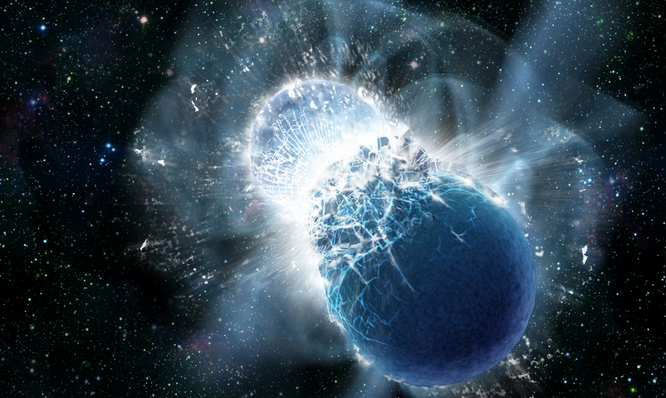Colliding neutron stars source of all the gold in universe

Contrary to what most people think, it appears that gold did not form inside our planet eons ago. The reason for this conclusion is simple. Gold is heavy, and have it formed before Earth's crust solidified it would have sunk through the liquid rock and vanished deep into the Earth's core.
Existing studies have already suggested that gold, and other heavy metals that are mined today, fell to Earth approximately 3.8 billion years ago when Earth was bombarded by billions of tons of material in the course of massive asteroid shower.
In a new study, researchers at Harvard-Smithsonian Center for Astrophysics (CfA) state that gold cannot be created within a star. Instead, it must be born in a cataclysmic event – like one that occurred last month and known as a short gamma-ray burst (GRB).
Observations of this GRB provide evidence that it resulted from the collision of two neutron stars – the dead cores of stars that previously exploded as supernovae.
Moreover, a unique glow that persisted for days at the GRB location potentially signifies the creation of substantial amounts of heavy elements – including gold.
"We estimate that the amount of gold produced and ejected during the merger of the two neutron stars may be as large as 10 moon masses – quite a lot of bling!" says lead author Edo Berger, CfA

This animation shows the collision and merger of two neutron stars. Merging neutron stars can create an event known as a short gamma-ray burst.
Credit: Dana Berry, SkyWorks Digital, Inc.
Berger and his colleagues studied GRB 130603B which, at a distance of 3.9 billion light-years from Earth, is one of the nearest bursts seen to date.
Gamma-ray bursts come in two varieties – long and short – depending on how long the flash of gamma rays lasts. GRB 130603B, detected by NASA's Swift satellite on June 3rd, lasted for less than two-tenths of a second.
Although the gamma rays disappeared quickly, GRB 130603B also displayed a slowly fading glow dominated by infrared light. Its brightness and behavior didn't match a typical "afterglow," which is created when a high-speed jet of particles slams into the surrounding environment.
Instead, the glow behaved like it came from exotic radioactive elements. The neutron-rich material ejected by colliding neutron stars can generate such elements, which then undergo radioactive decay, emitting a glow that's dominated by infrared light – exactly what the team observed.
"We've been looking for a 'smoking gun' to link a short gamma-ray burst with a neutron star collision. The radioactive glow from GRB 130603B may be that smoking gun," explains Wen-fai Fong, a graduate student at the CfA and a co-author of the paper.
The team calculates that about one-hundredth of a solar mass of material was ejected by the gamma-ray burst, some of which was gold. By combining the estimated gold produced by a single short GRB with the number of such explosions that have occurred over the age of the universe, all the gold in the cosmos might have come from gamma-ray bursts.
"To paraphrase Carl Sagan, we are all star stuff, and our jewelry is colliding-star stuff," says Berger.
The team's results have been submitted for publication in The Astrophysical Journal Letters and are available online. Berger's co-authors are Wen-fai Fong and Ryan Chornock, both of the CfA.
The finding was presented in a press conference.
Source: CfA
-
A neutron star is a type of stellar remnant that can result from the gravitational collapse of a massive star during a Type II, Type Ib or Type Ic supernova event.




Featured image:This artist's conception portrays two neutron stars at the moment of collision. New observations confirm that colliding neutron stars produce short gamma-ray bursts. Such collisions produce rare heavy elements, including gold. All Earth's gold likely came from colliding neutron stars.
Credit: Dana Berry, SkyWorks Digital, Inc.

Theory; that 3.8 my a our sun was a hyper giant that imploded due to a magnetic field wrap of such strength that all the energy was kept inside the edge of the hyper giant. That means that the energy that created the rocky planets was from the imploded star. The gas giants were the first planetary system; the second being the rocky planets created when the bettle sun imploded. These rocky planets coalesced inside the previous body of the bettle sun which had decreased to our Sol.
all very well and good, but the THEORY presupposes a universe that is many times older than the one we reside in. perhaps at the end of the day scientists will be proven to be nothing more than the seamstresses who made the emporers "new clothes".